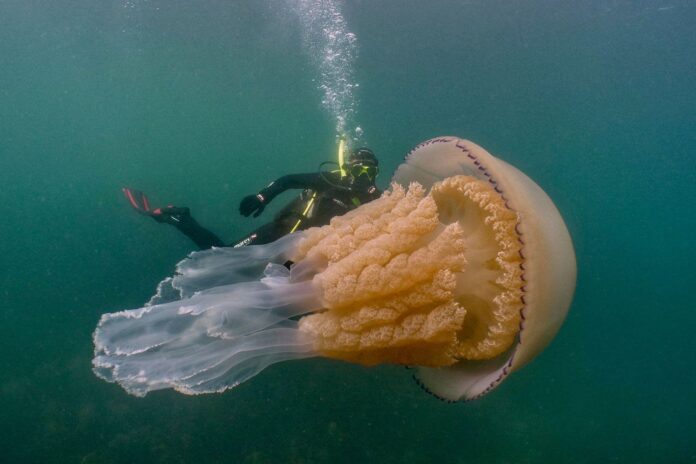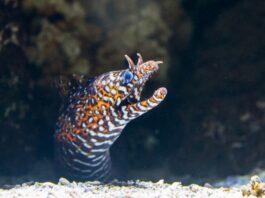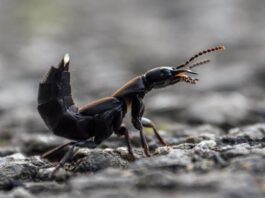When it comes to large jellyfish, we talk about the size of their bells more than the length of their tentacles. With over 2,000 jellyfish species in the oceans around the world today, we will only talk about the 5 largest ones. Some are colorful, while others have a very mesmerizing appearance that you might like. Let’s find out and see the large jellyfish species with me below.
5Black Sea Nettle
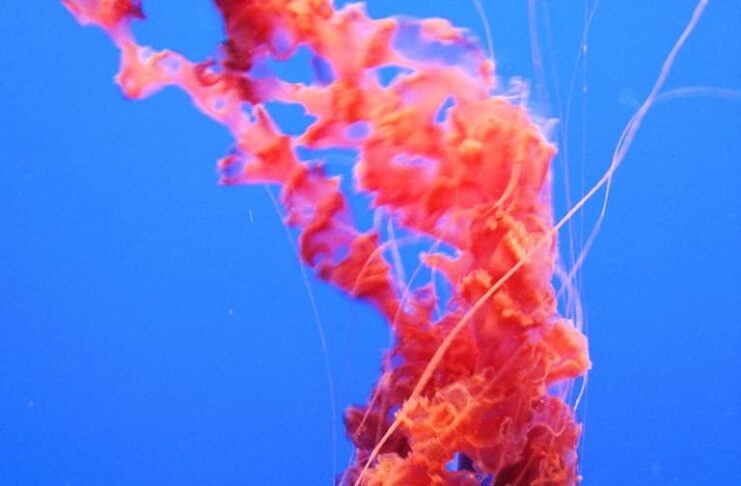
Scientific Name: Chrysaora Achlyos
Bell Size: 40 to 91 centimeters
The black sea nettle aka the black jellyfish, is a large jellyfish that comes with both appearance and size. Its bell has a distinctive opaque dark purple to nearly black color, with a lighter brown pattern. However, the most common colors that we usually see are reddish to maroon. This bell can be as large as 1 meter, while the jellyfish’s oral arms reach the length of 5 to 6 meters. Along with that, it also has stinging tentacles that are at least 7 meters long. The mouth of the jelly is in the center of one end of the body, and it is surrounded by the tentacles. When swimming, the tentacles trail behind, and they will sting prey that comes into contact. Then the oral arms capture food and deliver it to the mouth.
The black jellyfish lives in the open waters of the Pacific Ocean, inhabiting calm coastal waters and bays. They thrive in the murky depths of the waters, and they prefer dimly lit waters where sunlight barely penetrates. This jelly feeds on crustaceans, small fish, zooplankton, and other jellyfish that it crosses paths with. When capturing prey, a black sea nettle uses its stinging tentacles to immobilize the food before obtaining it. Each tentacle has thousands of microscopic nematocysts along with a coiled stinging filament that can eject venom-coated filaments upon contact. This alone has just enough toxins to kill smaller prey or stun its predators. The effects are different on humans as we will feel a painful stinging sensation that lasts for at least half an hour. This is why it is best to avoid touching jellyfish, no matter how pretty they look.
4Barrel Jellyfish
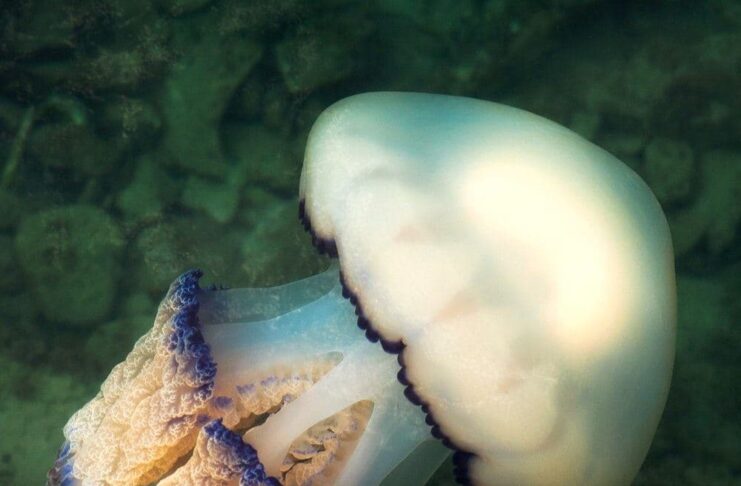
Scientific Name: Rhizostoma Pulmo
Bell Size: 1 meter
Looking like a floating cloud, barrel jellyfish has the most dreamy-looking bell you can ever imagine. The bell of this jelly can be as large as 90 centimeters up to 1 meter, and it has 8 frilly arms. If you look closely, you can see a violet fringe around the bell, which contains sense organs. The bell is usually clear, but sometimes it is also translucent blue, pink, or yellow as well. As for the arms, each of them contains small stinging tentacles and hundreds of little mouths. Beautiful but dangerous, barrel jellyfish has a venomous sting though not serious to humans. A sting from this jelly has side effects such as dermatitis, mild burning sensation, and ulcers.
This large jellyfish species floats in the shallow waters of the Black Sea, the Mediterranean Sea, and the Sea of Azov. When the temperature in the water rises, their population also increases. It is common for them to swarm off the coast in summer and fall, causing their washing up in large numbers. Something to have in mind is that even if seeing them shore, you should still avoid touching them. Those arms can still sting even after they are separated from the bell. These jellyfish feed on plankton, and they fall prey to the leatherback turtle. Their population is doing well, but they are also facing threats including climate change, habitat loss, and prey depletion from overfishing.
3Big Red Jellyfish
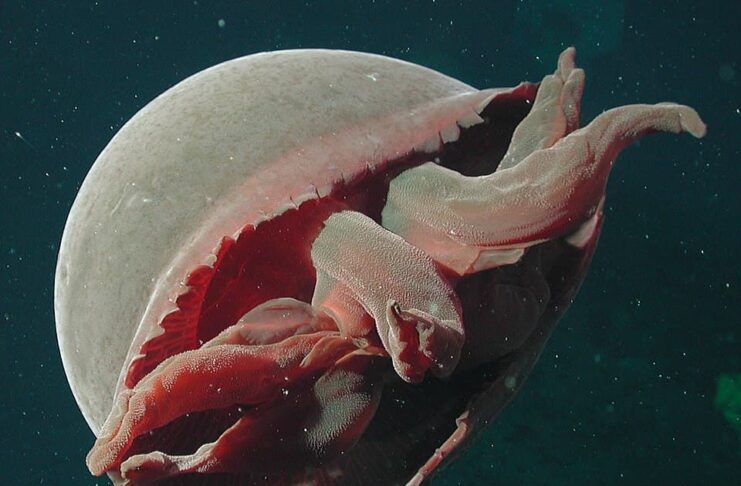
Scientific Name: Tiburonia Granrojo
Bell Size: 80 to 150 centimeters
While most large jellyfish species out there have lengthy tentacles, this one is completely the opposite. It has a deep red bell that is around 1 meter in diameter, and it has 4 to 7 flesh arms. That’s right, thick fleshy arms instead of thin tentacles; and they still can grab food very well. The big red jellyfish lives deep in the Pacific Ocean, from Baja California to Hawaii and Japan, inhabiting the bathyal zone. Living at a depth of 600 to 1,500 meters, their habitats have dim light and low temperatures along with high pressures. According to the conditions of the deep-sea habitat, their diet may consist of small crustaceans, zooplankton, and other organisms. It is a new species, and this jelly is a deep-sea creature, so there is very little information about this one.
2Nomura’s Jellyfish
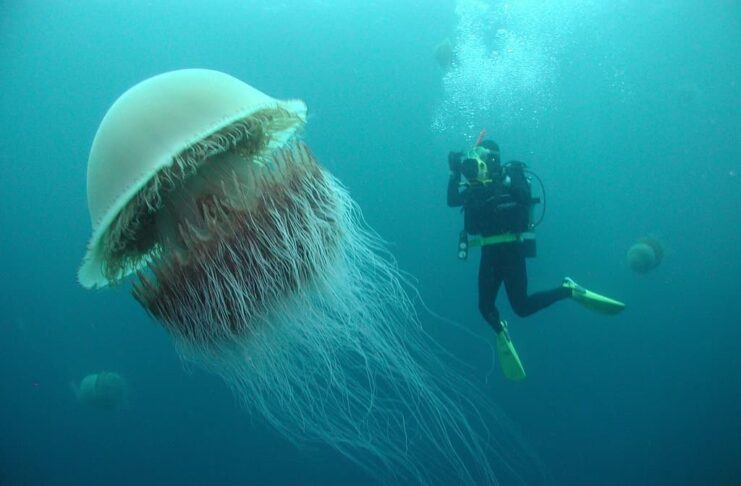
Scientific Name: Nemopilema Nomurai
Bell Size: 2 meters
Being one of the largest jellyfish species, a fully grown Nomura’s jellyfish is larger than an average human. It has a bell size of around 2 meters, and the whole appearance of the cnidarian is out of this world. A Nomura’s jellyfish has a translucent whitish body with pinkish or reddish capulets and oral arms. Their colors vary depending on what they feed on, and that is also quite fascinating. For example, they are more pinkish in color if they eat more shrimp in their habitats. Those murderous tentacles can be over 6 meters long, and a touch from one is quite deadly. A jelly of this size does have powerful stinging venoms, with unpleasant symptoms even to humans. Those who had been stung experienced acute pain, inflammation, itching, local erythrosis, swelling, and even death in severe cases.
As for this large jellyfish species, they are common in the waters of East Asia, mainly between China, Japan, and Korea. They feed mostly on tiny organisms and zooplankton, and their predators are humans, leatherback turtles, sunfish, swordfish, and tuna. A company in Japan actually produces vanilla and jellyfish ice cream using this jellyfish. Though edible and existing as a drinking snack in Japan, Nomura’s jellyfish does not have the best taste. If we talk about the population, there are more of them than we need. A jellyfish of this size can cause a lot of problems when they travel in groups called a bloom. One bloom that drifts to the wrong place at the wrong time can capsize and sink a fishing boat. Yes, that happened.
1Lion’s Mane Jellyfish
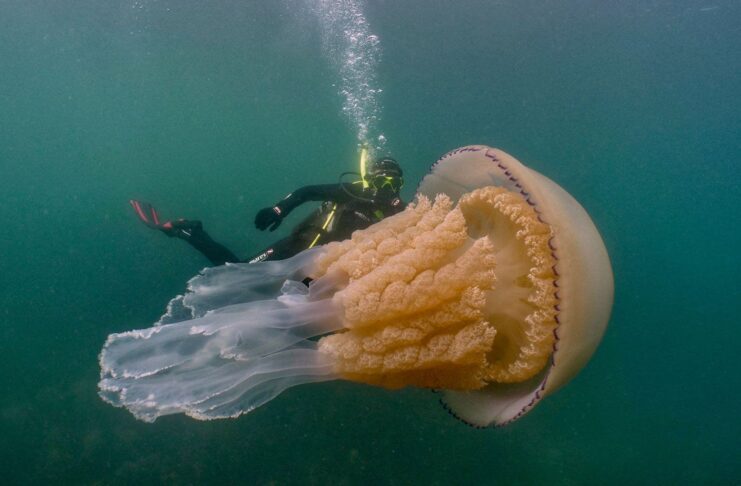
Scientific Name: Cyanea Capillata
Bell Size: 2.1 meters
Here you are looking at the largest jellyfish species in the water realm, the lion’s mane jellyfish. A lion’s mane jellyfish has a bell that is at least 1.8 meters, with tentacles that stretch to around 36 meters. The long and trailing tentacles of this jelly earn it its name as it resembles a lion’s mane. Young lion’s mane jellyfish have a lighter orange or tan bell, and it is red in adults before darkening as they age. One of the unique features of this giant jellyfish is that its bell is divided into 8 lobes. So instead of having a circular bell, its bell looks like 8 different sections binding together. Also, each lobe contains about 70 to 150 dark yellow or red stinging tentacles that it uses to stun and capture prey.
It has a range across the Arctic and the North Pacific Ocean, living in open waters. Being super large, it actually lives near the surface instead of deep in the water. Its diet is very similar to other jellyfish as it includes fish, other jellyfish, and zooplankton. Unlike the Nomura’s jellyfish, the lion’s mane is rather solitary, so you won’t see them in a bloom. Though traveling alone, it is very common to see large individuals have the company of many small fish. Those fish seek protection from predators because very few animals approach the lion’s mane jellyfish. Divers and swimmers often come across this jellyfish, and its long tentacles are hard to avoid. In healthy individuals, encounters with this jelly only result in localized redness and temporary pain. However, swimming into one is painful, no matter how healthy you are.
Related Post: Venomous Jellyfish To Avoid

